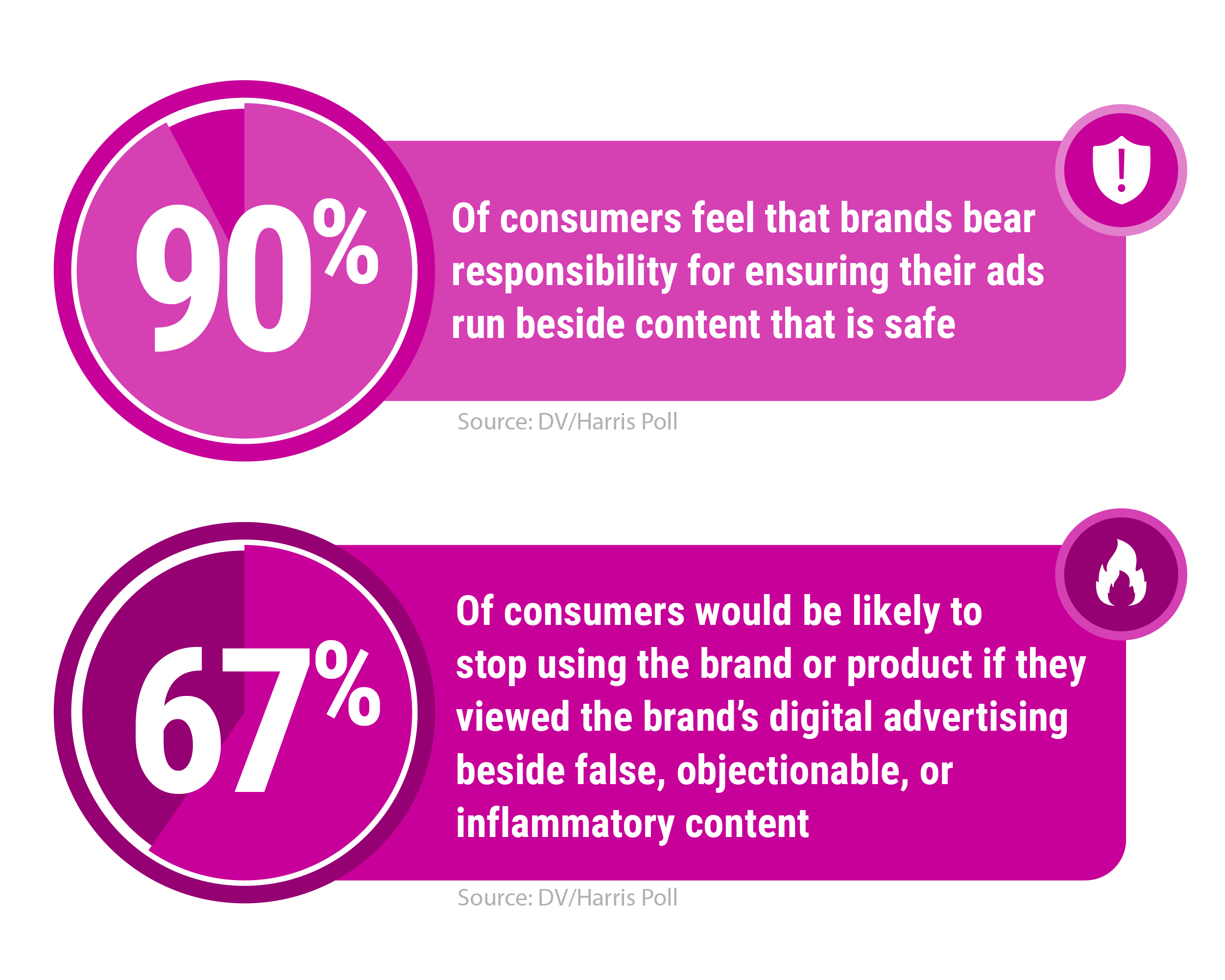Updated as of November 18, 2024
Today’s digital landscape can be a minefield of polarizing and misleading content.
That’s why now more than ever, brand safety and suitability guardrails are a must-have in any advertiser’s tech stack. Research from DV and Harris poll found that nearly 90 percent of consumers feel that brands bear responsibility for ensuring their ads run beside content that is safe. Two-thirds (67 percent) of consumers would be likely to stop using the brand or product if they “viewed the brand’s digital advertising beside false, objectionable or inflammatory content.”

Prevention is the first barrier of defense; the best way to protect reputation and investment is at the pre-bid phase. At DV, we always recommend our proven solution, DV Authentic Brand Suitability, which gives brands granular control over their suitability settings using functionality that aligns with current industry standards.
Something we often hear from advertisers, though, is the belief that unsuitable content can be avoided altogether by bidding on private marketplace (PMP) inventory, where brands can access high-quality publisher content. This inventory seems safe and suitable with minimal quality assurance (QA) checks required — but that’s not always the case. According to eMarketer, PMP deals will account for the majority (62.7 percent) of global programmatic real-time bidding (RTB) ad spend this year — and is projected to increase incrementally to 64.8 percent in 2025. While PMPs are generally recommended as a way to reach audiences in quality digital environments, unsafe, fraudulent activity can still occur. That is why we maintain our recommendation of brand safety and suitability protections as a way to ensure brand alignment at scale — even in PMP transactions.
Authentic Brand Suitability Reduces Violation Rates in PMPs By 61%
In 2021, we ran an analysis across the DV network that included programmatic partners who had not enabled Authentic Brand Suitability and measured a post-bid brand suitability violation rate of 11 percent in PMP transactions. This was 22 percent higher than post-bid brand suitability violation rates in open marketplace transactions when looking at the same programmatic partners. This tells us that regardless of where inventory is transacted, private or open marketplace, there is a risk for brand safety violations and media waste.
However, like any programmatic exchange, these violations can be significantly reduced by applying Authentic Brand Suitability. More recently, in 2024, we ran an analysis on the impact of Authentic Brand Suitability on PMP transactions, which included a year’s worth of data from one of our largest programmatic partners. This allowed us to compare post-bid brand suitability violation rates for PMPs where Authentic Brand Suitability was and was not applied versus PMPs. The data showed that the post-bid brand suitability violation rate for PMP deals with Authentic Brand Suitability applied was 61 percent lower than PMPs where Authentic Brand Suitability was not applied.

Modify Your Authentic Brand Suitability Settings to Balance Scale and Protection
To ensure quality while maintaining scale, we recommend building a less restrictive version of your open marketplace brand safety and suitability profile to use in PMP transactions. Here are some profile modifications we commonly see clients implementing to balance scale and protection for PMPs:
1. Allow Unknown Pages and Sites
“Unknown” pages and sites can significantly impact scale on campaigns. While this is a recommended feature to reduce blocking where activity can’t be identified pre-bid, it may cause restrictions with niche targeting. Allowing unknown activity on PMP transactions can be a quick fix if the targeted activity is blinded or incomplete in the action.
2. Create Exception Lists in Your Authentic Brand Suitability Profile
A quick win for programmatic deals is the use of exception lists in the Authentic Brand Suitability profile. These are sites or content you definitely intend to advertise on. Site exceptions will allow an entire domain to serve regardless of the content classifications which may be flagged. App exceptions will allow an entire CTV or mobile app to serve ads regardless of the content classifications. There is also the option for page exceptions, which allow a specific page to serve regardless of the content classifications. This is especially useful for homepages or sections pages that have aggregated content which can flag for many categories.
3. Review Your Keywords Regularly
Keyword blocking gives advertisers the ability to block specific keywords or phrases that they designate within a URL. Although keyword blocking is a useful brand suitability tool for emerging news events, it is not as nuanced as our avoidance categories and may result in unintentional blocking.
When activating and reviewing keywords, specificity is important. For example, including a broad word like “riot” would likely result in overblocking because it would cover all instances of the word riot, including phrases such as, “it’s a laugh riot!” or “riot grrrl.” A more specific phrase, such as “capitol riot,” limits the incremental rate-of-avoidance.
In addition to these profile setting modifications, we also suggest that clients transacting programmatically implement DV’s Programmatic Analytics for robust programmatic reporting, from auction to delivery. Programmatic Analytics allows you to monitor and understand the impact of pre-bid settings on post-bid delivery. For example, you could identify sites or pages with high brand suitability violation rates, uncover non-transparent inventory preventing efficient pre-bid avoidance and then add them to your Authentic Brand Suitability profile block list to reduce blocking and wasted ad spend.
Get Started with Authentic Brand Suitability
Download our Authentic Brand Suitability one-sheet or contact us if you’d like to learn more about how you can leverage DV’s Authentic Brand Suitability solution to improve the effectiveness of your campaigns on either open market or PMP transactions.

